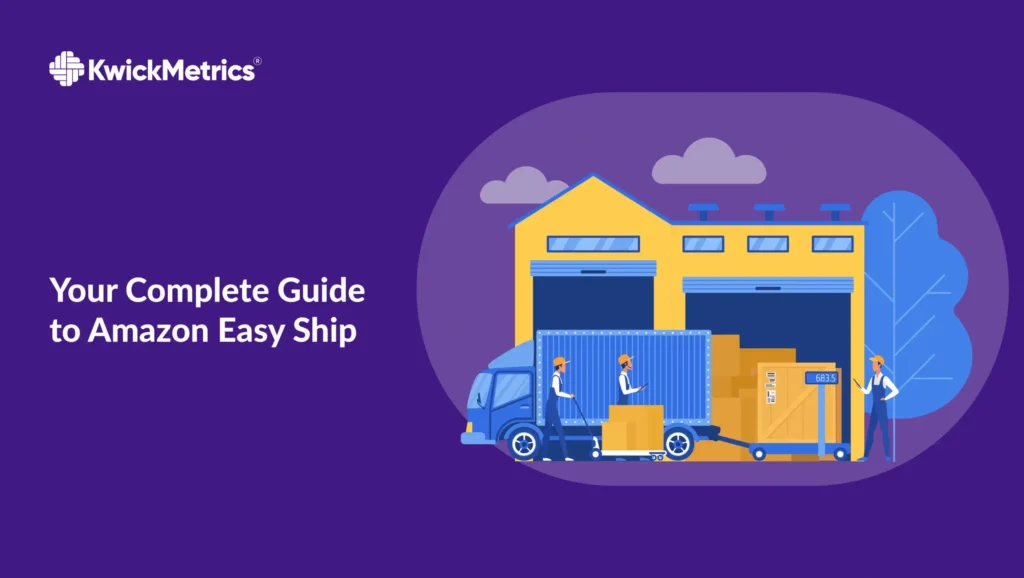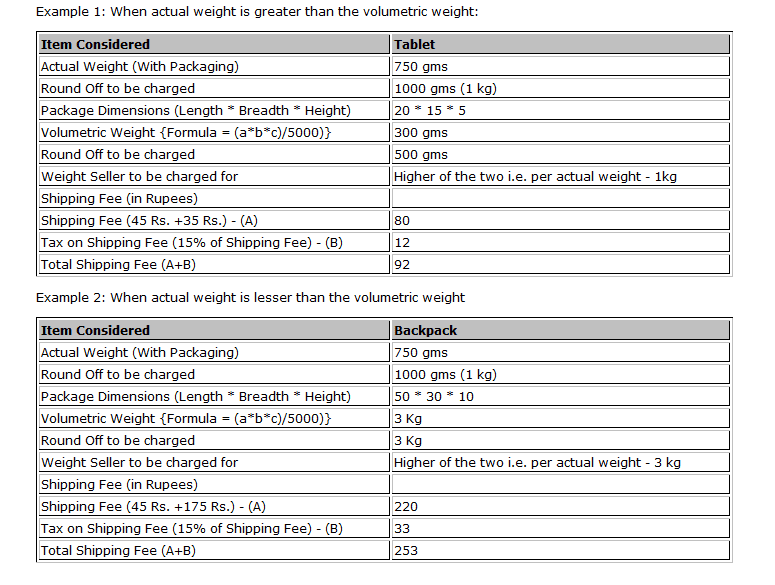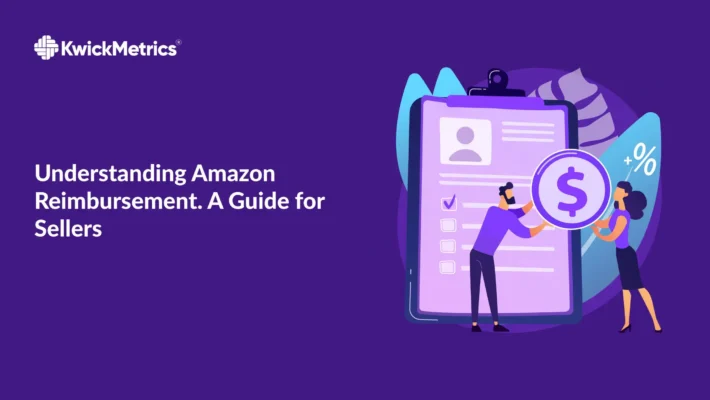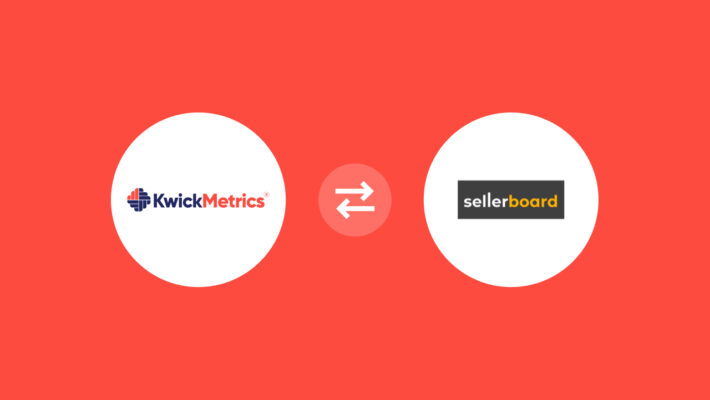Your Complete Guide to Amazon Easy Ship

Table of Contents
- What is Amazon Easy Ship?
- How does Easy Ship work?
- Who would benefit from Easy Ship?
- Benefits of using Easy Ship
- Drawbacks of using Easy Ship
- What are the current limitations of Amazon Easy Ship?
- What products cannot be shipped through Amazon Easy Ship?
- What are the fees charged by Amazon for sellers using Easy Ship?
- KwickMetrics - The Business Intelligence and Analytics Tool
- How to calculate the fees?
- How to calculate profit?
- FAQs related to the Amazon Easy Ship
- Conclusion
- Try our Amazon Analytics Tool with a 14-day Free Trial!
Welcome to your complete guide to Amazon Easy Ship! This blog breaks down everything you need to know in simple terms. Learn how to list and store products, handle orders, and understand the fees involved in Easy Ship fulfillment method. Whether you’re just starting out or looking to optimize your selling process, we’ve got all the information you need to succeed with Amazon Easy Ship!
What is Amazon Easy Ship?
Among the diverse fulfillment methods offered to Amazon Sellers, Easy Ship stands out as an ideal solution for those who aim to maintain product stock in their own warehouses while requiring support with shipping and delivery logistics. This service, exclusively launched in India, caters to sellers who prioritize inventory management and value full control over their operations.
Amazon Easy Ship is a delivery service for Amazon.in sellers. It makes it easy for sellers to get their orders delivered to customers’ doorsteps. Here’s a simplified explanation:
Amazon Easy Ship picks up orders from sellers’ warehouse and delivers them to buyers’ homes. Sellers don’t have to worry about delivery; Amazon handles it all. It’s great for sellers who have their own warehouses and want Amazon to manage delivery. With Easy Ship, buyers can track their orders and choose to pay when they receive them. It’s one of the convenient ways to sell products on Amazon.in.
| Aspect | Description |
|---|---|
| Storage | You will store your products in your own warehouse location that is registered with Amazon |
| Packaging | You can pack your products using Amazon packaging material or your own packaging material |
| Shipping (Pick up) | You will schedule a pick-up and an Amazon agent will pick-up from your registered warehouse location, delivering your product to the customer |
| Shipping | Amazon agent will deliver your package to the customer ensuring timely delivery |
| Tracking | The buyer has the facility to access the tracking until delivery |
Key Takeaway:
Control Over Storage and Packaging: Amazon Easy Ship allows sellers to maintain control over their storage facilities and packaging choices, whether utilizing Amazon's materials or their own.
How does Easy Ship work?
- Sign Up and List Products: First, sign up as an Amazon.in Seller and list your products. You can do this through Seller Central or the Seller App.
- Store Your Products: Once your products are listed, store them in your own warehouse. You’ll need to provide your warehouse address to Amazon for easy pickups.
- Receive Orders: When customers order your products on Amazon.in, you’ll receive notifications via email, Seller Central, or SMS.
- Schedule Pickup: After receiving an order, schedule a pickup for the product. Make sure the product is packed according to Amazon guidelines and ready for pickup. You can use Amazon packaging material if needed.
- Delivery by Amazon: Amazon’s delivery network, covering 99% of India’s pin codes, will deliver your products to the customers swiftly and reliably.
- Happy Customers: Customers can take advantage of delivery tracking, ensuring satisfaction and potentially boosting product ratings. Amazon facilitates tracking, although it’s managed within the Seller’s own warehouse.
Key Takeaway:
Efficient Shipping Process: Sellers can schedule pickups from their registered warehouse locations, with Amazon agents ensuring timely delivery to customers' doorsteps.
Who would benefit from Easy Ship?
-
- Sellers with Warehouse Facilities: This fulfillment method is suitable for sellers equipped with their own warehouse facilities and who would like to manage their own inventory and have complete control over it ensuring efficient storage and management.
- Diverse Product Range: Ideal for sellers dealing with a variety of products with tighter margins, looking to leverage Amazon’s expertise in delivery.
Benefits of using Easy Ship
-
- Wide Delivery Coverage: Deliver to 99.9% of India’s pin codes.
- Convenient Payment Options: Customers can Pay on Delivery (COD) with cash or card.
- Order Tracking and Assured Delivery: Customers can track orders with assured delivery dates.
- Efficient Returns Handling: Amazon handles customer returns, simplifying the process.
- No Shipping Hassles: Ship from home or office without dealing with couriers.
- Pickup Convenience: Amazon picks up customer Returns from the customer location.
- Customizable Packaging: Choose packaging that suits your products and budget.
Drawbacks of using Easy Ship
-
- High Costs: Amazon charges hefty fees, including referral, closing, and shipping fees.
- No Courier Choice: Sellers can’t choose their courier partner, relying solely on Amazon’s logistics network.
- Lack of Inventory Management: Managing inventory and shipping separately can be confusing and time-consuming.
- Delayed Payments: Amazon pays sellers only once a week, affecting cash flow and stock management.
- Limited Payment Options: Sellers are forced to offer pay on delivery, leading to potential issues like order cancellations and returns.
- No Insurance: Easy Ship doesn’t provide insurance for shipments, leaving sellers vulnerable to losses.
What are the current limitations of Amazon Easy Ship?
-
- Sellers who fulfil from a single pick-up location (not multiple warehouses)
- Pickup from your doorstep between 9am-5pm (local time)
- Minimum of 2 days Handling Time (can be changed under Shipping Settings)
What products cannot be shipped through Amazon Easy Ship?
-
- Any product weighing above 18 Kgs.
- Any product with dimension in excess of 70cm x 70cm x 45cm.
- Multi Package Shipments.
What are the fees charged by Amazon for sellers using Easy Ship?
Easy Ship fees are determined by two primary factors:
-
- Geography/Location
-
- Product Weight & Size.
Geography/Location plays a significant role in determining the cost, categorized as follows:
-
- Local Fees: Applied for intra-city pickup and delivery, where both the origin and destination are in the same city.
- Regional Fees: Applicable when the shipment moves within the same region but the delivery is outside the pickup city. There are four regions defined within the Easy Ship module.
- National Fee: Applied when the shipment moves across regions, for instance, from region 1 to region 2 or region 2 to region 3.
Easy Ship fees are also influenced by the volumetric or actual weight of the package, whichever is higher. The volumetric weight is calculated using the formula:
Volumetric Weight (kg)=(Length×Breadth×Height)/5000
where the dimensions (Length, Breadth, and Height) are measured in centimeters (cm).

KwickMetrics - The Business Intelligence and Analytics Tool
Explore 14-day free trial! No credit card required, cancel at any time.
How to calculate the fees?
Referral fees:
To calculate the referral fee charged for Easy Ship alone, you would need to know the category of the product being sold through Amazon.in’s Easy Ship program. Once you have identified the category, you can refer to the provided table to determine the referral fee percentage applicable for that category.
Let’s say you’re selling a product categorized under “Electronics (Camera, Mobile, PC, Wireless) & Accessories” through Easy Ship. According to the table, the referral fee percentage for this category varies based on the price range of the item.
Suppose the selling price of the item is INR 800. Looking at the table, the referral fee percentage for this price range is 17%.
So, to calculate the referral fee charged for Easy Ship alone:
Referral Fee = Item Price x Referral Fee Percentage Referral Fee = INR 800 x 17% Referral Fee = INR 136
Therefore, the referral fee charged for Easy Ship alone for a product priced at INR 800 in the “Electronics (Camera, Mobile, PC, Wireless) & Accessories” category would be INR 136.
Closing fees:
To calculate the closing fee for Easy Ship alone, you need to follow these steps:
-
- Determine the item price range.
-
- Identify the fixed closing fee associated with that price range for Easy Ship.
-
- Apply any exceptions based on the category.
Let’s break it down with examples:
Example 1: Selling Books at ₹200 shipped with Easy Ship
-
- Item price falls in the range of ₹0 – 250.
-
- The fixed closing fee for this range with Easy Ship is ₹4.
-
- Since Books category is in the exception list for ₹0-250, the closing fee remains ₹4.
So, for Easy Ship, you first identify the item price range, then find the corresponding fixed closing fee, and finally, apply any exceptions based on the category to determine the closing fee.
Weight handling Fees:
-
- Determine the item’s size: Standard or Heavy & Bulky.
-
- Identify the shipping distance: Local, Regional, or National.
-
- Refer to the Easy Ship Weight Handling Fee Table for the applicable fees based on size and distance.
-
- Apply the fees accordingly.
-
- Total the applicable fees to get the total shipping fees.
Example Calculation:
-
- Standard-size item weighing 2.2 kg
-
- Shipping from Mumbai to Pune (Regional)
-
- Based on the fee table:
-
- First 500 gms: ₹54.5
-
- Additional charge per 500 gms: ₹60.5
-
- Calculation: ₹54.5 (first 500 gms) + ₹242 (additional 1.7 kgs) = ₹296.5
So, the total weight handling fees for shipping this item using Easy Ship would be ₹296.5.
Size Guidelines:
Standard Items:
-
- Minimum chargeable weight: 500 gms.
-
- For items > 500 gms, charged in multiples of 500 gms.
-
- Amazon Shipping Fees computed on volumetric or actual weight, whichever is higher.
-
- Volumetric Weight (kg) = (Length x Breadth x Height) / 5000 (cm).
Heavy & Bulky Items:
Criteria for classification:
-
- Items from specific categories (e.g., washing machines, refrigerators, etc.)
-
- Item package weight > 22.5 kg.
-
- Maximum package dimensions exceed 72” or 183 cm.
-
- Girth > 118” or 300 cm.
-
- Multi-box items or items requiring carpenter installation.
-
- No specific mention of chargeable weight; presumably charged based on actual weight or volumetric weight.
The shipping fees for standard items are calculated differently from heavy and bulky items. For standard items, the chargeable weight starts from 500 gms, whereas for heavy and bulky items, there’s no mention of a minimum weight threshold.
How to calculate profit?
-
- Determine the referral fees based on the category of the product.
-
- Identify the closing fees corresponding to the item’s price range and fulfillment method.
-
- Compute the shipping fees if using Easy Ship or assess the shipping cost for Self-Ship.
-
- Total up all fees including referral, closing, shipping, and any other applicable fees.
-
- Calculate the profit by subtracting the total fees from the item’s sale price minus the cost of the product.
FAQs related to the Amazon Easy Ship
1. Is Amazon Easy Ship available globally?
-
- No, Amazon Easy Ship is currently exclusively launched in India and not available in other countries.
2. Can sellers opt for specific delivery time slots with Amazon Easy Ship?
-
- Unfortunately, Amazon Easy Ship does not offer the flexibility for sellers to choose specific delivery time slots for their orders.
3. Are there any restrictions on the types of products eligible for Amazon Easy Ship?
-
- Yes, certain products exceeding weight and dimension limits, as well as multi-package shipments, are not eligible for Amazon Easy Ship.
4. Does Amazon Easy Ship provide insurance coverage for shipments?
-
- No, Amazon Easy Ship does not provide insurance coverage for shipments, leaving sellers vulnerable to potential losses during transit.
5. Can sellers integrate Amazon Easy Ship with their own courier partners?
-
- No, Amazon Easy Ship does not allow sellers to integrate their own courier partners, relying solely on Amazon’s logistics network for order fulfillment.
Conclusion
In conclusion, Amazon Easy Ship caters to sellers seeking to optimize their delivery processes on Amazon.in. While Fulfillment by Amazon (FBA) is preferred by sellers aiming for streamlined operations, Easy Ship appeals to those who prefer storing inventory in their own warehouses and maintaining full control. Despite its advantages such as extensive delivery coverage, flexible payment options, and effective order tracking, sellers should be mindful of associated costs like referral, closing, and shipping fees, as well as limitations including delayed payments, product restrictions, and lack of inventory management. Ultimately, sellers must carefully assess Easy Ship’s benefits and drawbacks to align with their selling strategies effectively.



